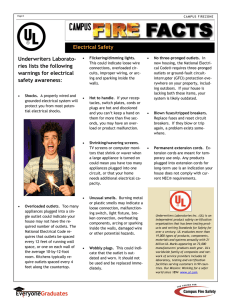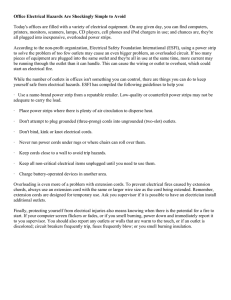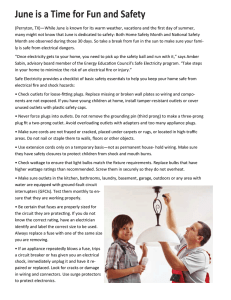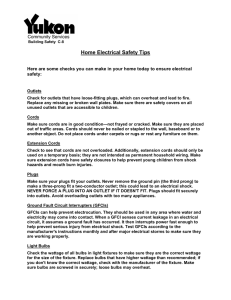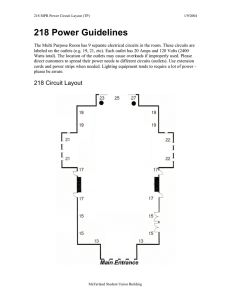commercial electrical safety
advertisement
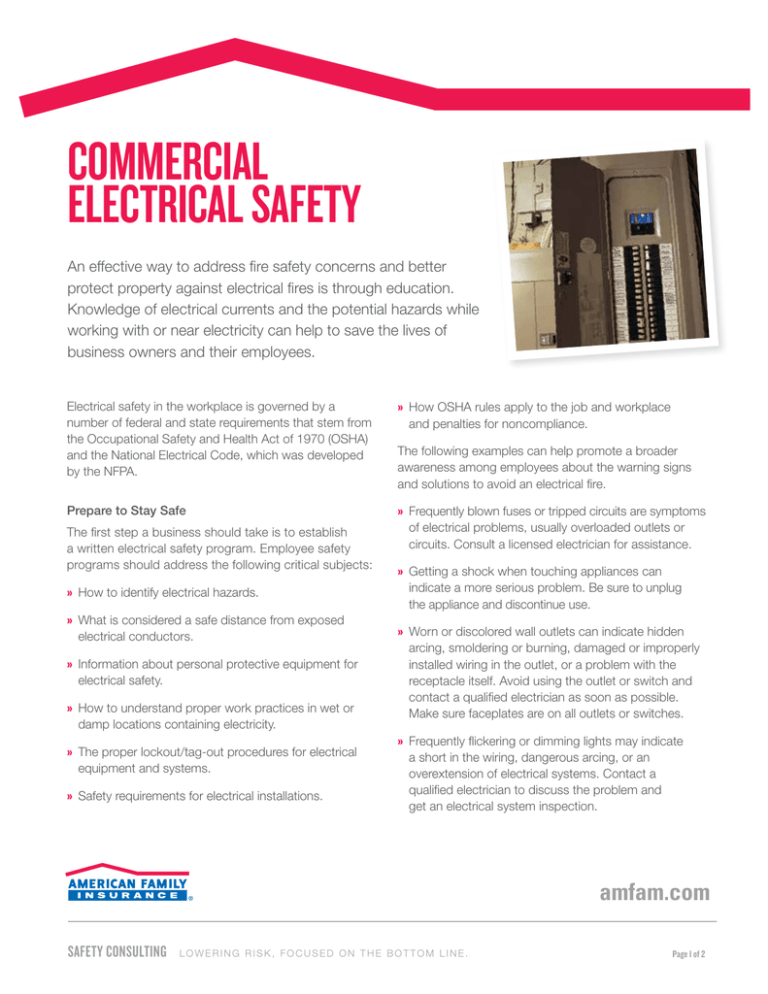
COMMERCIAL ELECTRICAL SAFETY An effective way to address fire safety concerns and better protect property against electrical fires is through education. Knowledge of electrical currents and the potential hazards while working with or near electricity can help to save the lives of business owners and their employees. Electrical safety in the workplace is governed by a number of federal and state requirements that stem from the Occupational Safety and Health Act of 1970 (OSHA) and the National Electrical Code, which was developed by the NFPA. »How OSHA rules apply to the job and workplace and penalties for noncompliance. Prepare to Stay Safe »Frequently blown fuses or tripped circuits are symptoms of electrical problems, usually overloaded outlets or circuits. Consult a licensed electrician for assistance. The first step a business should take is to establish a written electrical safety program. Employee safety programs should address the following critical subjects: » How to identify electrical hazards. »What is considered a safe distance from exposed electrical conductors. »Information about personal protective equipment for electrical safety. »How to understand proper work practices in wet or damp locations containing electricity. »The proper lockout/tag-out procedures for electrical equipment and systems. » Safety requirements for electrical installations. The following examples can help promote a broader awareness among employees about the warning signs and solutions to avoid an electrical fire. » Getting a shock when touching appliances can indicate a more serious problem. Be sure to unplug the appliance and discontinue use. »Worn or discolored wall outlets can indicate hidden arcing, smoldering or burning, damaged or improperly installed wiring in the outlet, or a problem with the receptacle itself. Avoid using the outlet or switch and contact a qualified electrician as soon as possible. Make sure faceplates are on all outlets or switches. »Frequently flickering or dimming lights may indicate a short in the wiring, dangerous arcing, or an overextension of electrical systems. Contact a qualified electrician to discuss the problem and get an electrical system inspection. amfam.com SAFETY CONSULTING LOWERING RISK, FOCUSED ON THE BOTTOM LINE. Page 1 of 2 COMMERCIAL ELECTRICAL SAFETY Reducing Risks By becoming familiar with the proper ways to use equipment in a workplace and by understanding the importance of using the right materials and the need for regular maintenance, employees and owners can minimize the risk of electrical fire. Only a professional should attempt to service or repair any electrical equipment. »Use caution when moving televisions and computer or video monitors, which contain two areas that have the greatest electrical dangers: the non-isolated line power supply and the CRT high voltage. Major parts of nearly all modern TVs and many computer monitors are directly connected to the AC line, so there is no power transformer to provide the essential barrier for safety. Additionally, in some TVs the entire chassis is live. »Microwave ovens use the chassis as ground return for the high voltage. »According to OSHA safety code requirements (ANSI/IEEE-C95.1-1991) the power density should not exceed 1.6 mW/cm2 at 2450 MHz (microwave oven frequency) for human exposure in uncontrolled environments. »Plugs and cords must be maintained and monitored. »Use appliances, tools, lighting and extension cords approved by a nationally recognized testing laboratory, such as Underwriters Laboratories (UL). »Unplug equipment and appliances if they will not be used for a prolonged period. »Frequently inspect cords and plugs to be sure they are not cracked or frayed and keep cords out of high-traffic areas in the workplace. »Make sure plugs fit outlets and never force a plug to fit the outlet. » Extension cords should be used only temporarily. »Do not staple or nail extension cords to walls or baseboards. »To prevent overloading an extension cord, limit the amount of equipment plugged into each outlet. »When handling static sensitive components, an anti-static wrist strap is recommended. »Always follow the lockout, tag-out and grounding procedures appropriate for the work environment. »Unplug tools and equipment before cleaning, adjusting or repairing them. »Lock the power switch in the “off” position and pull fuses to prevent a person or a time clock from starting equipment under repair. »Replace guards over augers, chains and belts before unlocking or re-fusing the power switch. »Use the recommended wattage when replacing light bulbs or the recommended amperage when replacing fuses. »If circuit boards need to be removed from their mountings, put insulating material between the boards and anything to which they may short. Hold them in place with string or electrical tape. Prop them up with insulation sticks—plastic or wood. »Use Ground Fault Circuit Interrupters (GFCI) in any area where water and electricity can come into contact. Outdoor outlets should have waterproof covers and be GFCI protected. »Farm operations should pay special attention to grounding. Insufficient or improper grounding, unbalanced electrical loads or faulty electrical equipment may cause stray voltage. Have a licensed electrician test the wiring and connections in farm buildings and equipment. Stray voltage may also be sources outside of the farm. For more information about American Family’s Safety Consulting Services, visit www.amfam.com DI SCLAI MER The recommendations printed here follow generally accepted safety standards. Compliance with these recommendations does not guarantee that you will be in conformance with any building code, or federal, state or local regulations regarding safety or fire. Compliance does not ensure the absolute safety of you, your operations or place of business. amfam.com SAFETY CONSULTING LOWERING RISK, FOCUSED ON THE BOTTOM LINE. American Family Mutual Insurance Company, American Family Insurance Company, 6000 American Parkway, Madison, WI 53783 Page 2 of 2 ADS-30820 Rev 3/14

